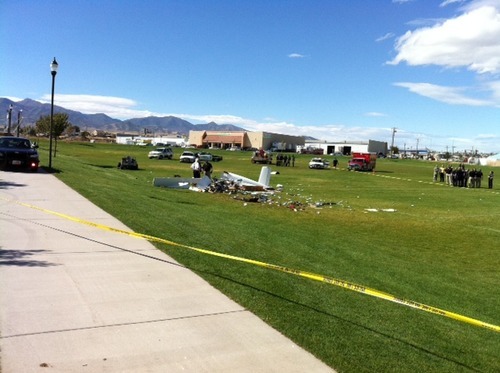This is an archived article that was published on sltrib.com in 2011, and information in the article may be outdated. It is provided only for personal research purposes and may not be reprinted.
Tuesday's light airplane crash in West Jordan has claimed its second victim, in what city and airport officials are calling an isolated incident despite another crash three weeks ago.
Jared Despain, the aircraft's 28-year-old pilot, died of massive injuries early Wednesday afternoon, West Jordan police Sgt. Drew Sanders confirmed. The plane's only passenger, 40-year-old Brent Simmons of Manti, died at the scene Tuesday, when the plane crashed in a soccer field near 7900 South and 4340 West.
Jerry Simmons said Wednesday night that his brother had wanted to fly for more than 20 years and had talked previously about purchasing a plane. Jerry Simmons said Brent had purchased the plane earlier in the day and planned to get flight instruction and eventually his license. He said the two men knew each other, and Jared Despain, who was a flight instructor, was trying to move the plane closer to the flight school Brent had selected when the crash occurred.
"It's hard to sum up a person," Jerry Simmons said of his brother, a cabinetmaker, who was passionate, generous, loving and forgiving of those who slighted him.
"Generally a good Samaritan," he said.
He said he hopes investigators can find answers about what caused the crash and said he's heard speculation that maybe the plane was to blame.
It was the second plane crash in West Jordan in the past month. On Sept. 15, another small plane went down within feet of the city's Columbia Elementary School, 3505 W. 7800 South. The plane's pilot and his dog died in the crash but no students were injured.
Despain had just taken off from the South Valley Regional Airport, 7536 South 4470 West. The plane that crashed Sept. 15 was attempting to land at the airport.
The crashes don't appear to be related, although it's still too early to know for certain, said Kurt Anderson, investigator in charge of the incident for the National Transportation Safety Board. Investigators are examining log books, weather data and information about pilots and passengers. The investigation into the cause of the crashes could take up to six months.
"You have to look at each one individually, see what happened and why it happened," Anderson said. "Then we can see if there is any relationship between the two."
A rainstorm moved into the area just before the crash Tuesday, but it was unknown if that was a factor.
The two plane crashes have prompted West Jordan to review its safety procedures, said Mayor Melissa Johnson, to ensure that first responders are prepared. However, the city has no plans to close the soccer fields or any other amenities near the airport. Future zoning and growth should not affect the airport, as most of the area was built out 15 to 20 years ago.
"By its very nature, an accident is something you can't predict and you can't plan for," Johnson said, adding that most plane crashes happen at the airport rather than in surrounding areas. She said the facility has an average accident rate.
West Jordan resident Robb Feltch lives between the two crash sites at 7998 S. 3960 West. He said Wednesday that airport neighbors aren't rattled by the recent two crashes, considering them freak accidents rather than an indication of a problem with the airport's location. He said he enjoys his proximity to South Valley.
"I actually like seeing the different styles of planes. They line up at night and make a trail of light. It's really pretty," he said.
South Valley Regional has served the area for almost 70 years and was previously surrounded by wide-open fields, said airport spokeswoman Barbara Gann. Even with the encroaching homes, schools and other developments, the airport continues to meet federal proximity regulations.
"We have a very strong safety record," Gann said. The Federal Aviation Administration would make any decisions about modifying, moving or closing the airport.
According to the Salt Lake City International Airport website, South Valley supports business-related flights, law enforcement and emergency services, recreational flights and charters. A Utah National Guard support facility is based at the airport, which has one runway.
South Valley helps relieve traffic at the Salt Lake City International Airport, Gann said, and primarily serves smaller planes.
The small Pulsar that crashed was classified as an experimental aircraft, but it still had to meet certain safety standards.
"Most experimental aircraft are built from a kit that is already approved by the FAA," said Mike Fergus, spokesman for the FAA Northwest Mountain Region. The craft must be assembled with the help of an FAA-certified mechanic, pass a test flight and receive an air-worthiness certificate.
The FAA keeps a database of common aircraft ailments, Fergus added, and all crashes are compared to look for trends. If anything other than pilot error is to blame, the agency can take steps to prevent future incidents.
"If more than one [crash] came up with a problem, it would pop up as a red flag," Fergus said. "It would come to our attention."
Twitter: @Katie_Drake
Tribune reporters Bob Mims and Janelle Stecklein contributed to this story.





